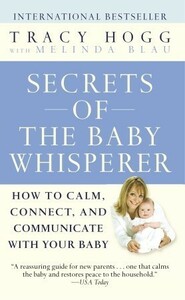Take a photo of a barcode or cover
110 reviews for:
Secrets of the Baby Whisperer: How to Calm, Connect, and Communicate with Your Baby
Melinda Blau, Tracy Hogg
110 reviews for:
Secrets of the Baby Whisperer: How to Calm, Connect, and Communicate with Your Baby
Melinda Blau, Tracy Hogg
I sort of skimmed though most of this book, reading in more detail the parts about schedule. While most of the book was fluff (how many personal stories of her amazing powers can one take?), the discussion of the EASY schedule really helped us. Our baby really adapted well to EASY, but I'm not sure it was the book, or baby's natural schedule that lead to the success.
Since we adopted, we didn't get much time to read baby books. This was pretty much the only one, on recommendation from a friend who had success with EASY. And to be honest, we really didn't need the baby books. It seemed to come really naturally to us. Either that, or we were so clueless that we didn't know any better!
Since we adopted, we didn't get much time to read baby books. This was pretty much the only one, on recommendation from a friend who had success with EASY. And to be honest, we really didn't need the baby books. It seemed to come really naturally to us. Either that, or we were so clueless that we didn't know any better!
pretty good... what i liked that she found some middle ground between the two extremes (sears/carry your baby all day long vs. cry it out). i thought her philosophy seemed humane. i have to say that i didn't really use her method- or any other. i just found my own way. but this book does offer an approach that is sensitive to the needs of both babies and parents.
While Tracy Hogg had wonderful insight I found myself skimming through most of it waiting to find out she could help me. Too many examples, too much filler but I will try to use her method.
Evidently this woman did not "whisper" to Sam that he should Eat, be Active, Sleep, and give me "You" time in that order. Sam ate every two hours for a while; this structure was not feasbile. At the same time, she gave me a few helpful hints and I liked the idea of a loose structure.
I was looking for a magic bullet. This wasn't it and was disappointing after liking her first book.
Book was pretty naff but the easy schedule is amazing.
This book warped my new mama brain. For about a week I became too fixated on a schedule for my newborn rather than following my instinct. Didn't finish, but might revisit later ... now that I feel a bit more secure in my abilities as a mama :)
informative
This book helped the first time around to get max on a schedule. Hopefully, it will help the second time around to.
Take aways from this book:
1. Treat your child like an individual so you can better read their cues.
2. Eat, activity, sleep/you time in that order. This makes eating be more productive and doesn’t allow the child to depend on eating to sleep. The flexible routine allows you to better interpret your child’s cues. The basic schedule for the first three months is eat for 25-40 minutes and wait 2.5 hours-3 hours between feeds; activity for 45 minutes; sleep for about 1 hour. As the child gets older, feeding time decreases, activity increases, daytime naps decrease, and child sleeps more at night.
3. Slow down and interpret cues. Let them self soothe while sleeping and use pacifiers and patting to prevent needing external interventions to sleep. Pick up a crying baby, but put them back when they feel better.
1. Treat your child like an individual so you can better read their cues.
2. Eat, activity, sleep/you time in that order. This makes eating be more productive and doesn’t allow the child to depend on eating to sleep. The flexible routine allows you to better interpret your child’s cues. The basic schedule for the first three months is eat for 25-40 minutes and wait 2.5 hours-3 hours between feeds; activity for 45 minutes; sleep for about 1 hour. As the child gets older, feeding time decreases, activity increases, daytime naps decrease, and child sleeps more at night.
3. Slow down and interpret cues. Let them self soothe while sleeping and use pacifiers and patting to prevent needing external interventions to sleep. Pick up a crying baby, but put them back when they feel better.

